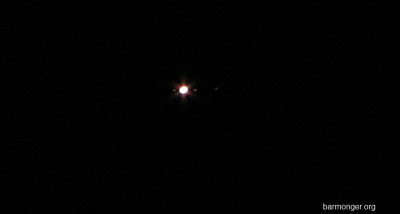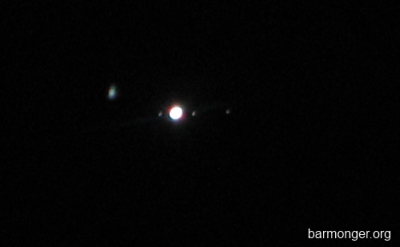We got more background information about the sky and what's visible in it and, more importantly, a thorough guide to using a planisphere.
I've seen them before but never tried using one. And now that I know how they work I can really appreciate how amazing they are and how easy they make finding stuff in the sky (unless you use Google Sky Map of course, then it's been easy all along).
Stargazing
After a bit of theory we went outside and had a look at the sky. We were shown different stars and constellations and talked a bit out sizes and distances. I also got the opportunity to look at Jupiter through a set of proper binoculars (mounted on a tripod). It was amazing, I've never seen the Jovian moons before live.
We were only able to see three of them and I'm not quite sure which of the 4 usual suspects (The moons seen by Galileo; Io, Europa, Ganymede and Callisto) we could see. Not that it mattered, it was really cool.
Update: It was Ganymede. This tool will help you determine the current position of the Galilean moons at any time
Pictures of jupiter
It also made me realize that seeing Jupiter and its moons doesn't require expensive telescopes or anything.
So I mounted our ageing camera (a Canon Powershot IS2) on a tripod and started taking pictures of Jupiter.
And apparently you can take pictures of the moons even with a crappy old camera.
This one was taken outside
This one is through a window
This one is also through a window, the blob on the left is a drop of water on the window
Awesome!



2 comments:
You must have been looking at around 9:00 PM EDT. At that time, one of the moons was in front of Jupiter, so seeing it would have been really hard.
George
According to this tool
http://www.skyandtelescope.com/observing/objects/javascript/jupiter#
Ganymede was behind Jupiter at 9 PM CEST (when I was outside).
At 9 PM EDT, Europa would be in front of Jupiter :)
I've updated the post to include a link to the javascript tool
Post a Comment